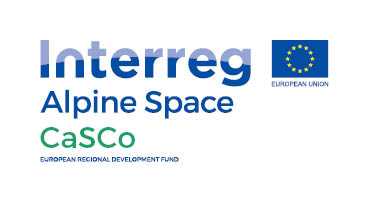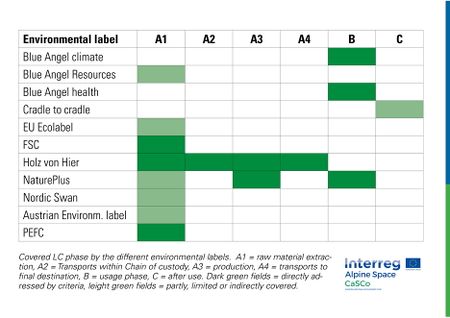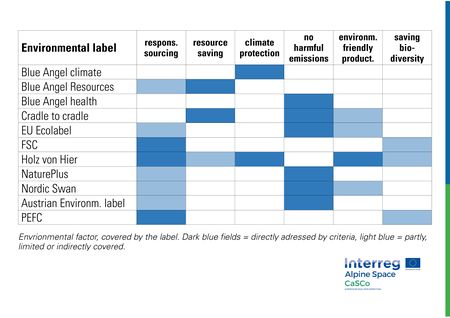Comparisons environmental labels
considered life cycle stages and environamental aspects
The following environmental labels were included in the evaluations (alphabetically): Blue Angel (blauerengel.de), Cradle to Cradle (epea.com), European Eco-label (eu-ecolabel.de), FSC (fsc.de), HOLZ VON HIER (holz-von-hier.de), NaturePlus (natureplus.org), Nordic Swan (nordic-ecolabel.org), Austrian Eco-label (umweltzeichen.at) and PEFC (pefc.de).
The life cycle phase covered by the respective eco-label: A1 = extraction of raw materials, A2 = transport along the chain of custody, A3 = production, A4 = transport to the construction site, B = use phase, C = subsequent use.
Dark green areas = directly covered by criteria, light green areas = partially, restricted or indirectly covered. Dark blue = directly covered by criteria, light blue = indirect effects or restricted effects.
Responsible sourcing
Sustainable and responsible raw material extraction should be a general requirement for all raw materials and materials used. However, corresponding environmental labels and certificates have so far developed and established themselves almost exclusively in the wood sector. Here, the two global forest certification systems FSC and PEFC are traditionally known. Other labels require corresponding proof for wood from sustainable forestry, albeit in different forms.
Sustainable forestry
The globally operating forest certification systems FSC and PEFC have two different types of standards: (1) the Forest Management Standard (FM) for the type of forest management and (2) the COC standard, which is intended to ensure that no more wood products with the forest label are marketed along the processing chain than the number of raw materials required for this purpose. Both systems offer different models within the COC Standard, on the one hand the model of physical separation of certified and non-certified material, on the other hand quantity weighted models such as the percentage method and the credit model. Only in case of physical segregation would a physical identity of wood in a certified product with wood from certified forests be guaranteed. In practice, such a guarantee is not (very rarely) given because already in the first stages of processing, volume-weighted models are predominantly used.
| Label | Wood from sustainable forestry |
|---|---|
| Blauer Engel | 50% of the wood should come from sustainable forest management, the rest from legal sources according to the EUTR. |
| EPEA | Cradle-To-Cradle wood "from sustainable management" is required, whereby the type of proof and the percentage could not be determined from the label website. |
| EU ecolabel | (1) 70% share from sustainable sources for solid wood, (2) 40% for wood-based materials |
| FSC | the proportion varies from any proportion in FSC mix and FSC controlled wood up to 100% in FSC pure |
| HOLZ VON HIER | 100% Quantity of wood used in certified products must come from sustainable forestry, proven by an FM certificate from FSC, PEFC or equivalent. |
| NaturePlus | Proof of the origin of the wood from sustainable forestry is required, the proportion is (unclear but) probably 100%. |
| Nordic Swan | Proportions vary between >10%, >50% up to >70% depending on the product standard. |
| Ö-UZ | 70% minimum share for wood energy, 50% for solid wood, floors, furniture, exterior wood. No information for insulation materials. |
| PEFC | the minimum percentage of the total quantity processed is specified in the PEFC standard, the material must come from PEFC certified forests |
Resource saving
The responsible use of resources is more important today than ever. We Europeans consume about twice as many resources as we have. The only resources that are renewable on a large scale in Europe are wood and straw.
| Label | aspect of resource conservation |
|---|---|
| Blauer Engel | Of the 113 Blue Angel standards, 20 relate to the protection of resources, none in the area of construction and renovation and only 5 of 20 with paper products. Here the claim "Conserve resources" means the use of waste paper or recycled paper. Other resource aspects are not the focus of the "Blue Angel - Saving Resources". |
| EPEA | The environmental label cradle to cradle (C2C) does not contain any specific criteria for the conservation of resources. However, the basic concept "elimination of waste (in theory) corresponds to the conservation of resources. The criterion of material recycling is to be seen in analogy to the principle of recycled paper at the Blue Angel. (Note: in practice, product cycles are generally far removed from the natural model of closed cycles). |
| EU ecolabel | The EU Ecolabel has not developed any direct criteria for resource protection and is reduced to the sustainable extraction of wood and low energy consumption in production. The energy consumption in production is usually calculated. |
| FSC | The central message of the FSC eco-label is the sustainable management of the forest to obtain the raw material wood. In addition to various social and environmental requirements, the focus of FSC is therefore on the conservation of wood as a resource by means of management that is intended to ensure its use for future generations. |
| HOLZ VON HIER | HOLZ VON HIER is characterized by renewable raw materials from sustainably managed forests. The transports in the processing chain and to the customer are above average short and therefore also save resources. |
| NaturePlus | NaturePlus demands a "preferably high" proportion of renewable raw materials in the product and a minimisation of energy consumption. |
| Nordic Swan | The Nordic Swan addresses resource conservation rather indirectly. In general, at least 50% of the materials should be renewable and, in the case of wood, at least 30% should come from sustainably managed forests. Energy consumption in production must not exceed a certain value and high-calorific production waste should be returned to the energy cycle. |
| Ö-UZ | The Austrian Ecolabel has not defined any specific criteria for the conservation of resources. The award criteria for furniture are defined as regulations for raw materials, which primarily concern the avoidance of ingredients that are hazardous to health, as well as environmentally friendly production, durability and waste reduction, and packaging aspects. |
| PEFC | The central message of the PEFC eco-label is the sustainable management of the forest for the extraction of the raw material wood. In addition to various requirements, the focus is on the conservation of wood as a resource by means of a management system that is intended to safeguard this use for future generations. |
climate protection
Für Klimaschutzmaßnahmen gibt es in den Lebenszyklusphasen unterschiedliche Ansatzpunkte, entweder in den Vorketten der Herstellung (LC Phase A1,A2, A3, A4) oder in der Nutzungsphase (B) des Produktes.
Klimafreundliche kurze Wege und die damit verbundenen Umweltwirkungen der gesamten Verarbeitungskette "cradle-to-gate" (A2) sowie vom Produktionsort zum Einsatz- oder Verwendungsort "gate-to-customer" (A4) werden durch das Umweltzeichen HOLZ VON HIER erfasst. Die Emissionen aus solchen Transportwegen können bei den heute internationalen Märkten auch für Holzprodukte leicht ein Vielfaches der Gesamtemissionen der Herstellung des Produktes erreichen. Das Umweltlabel Holz von Hier ist hier einzigartig, da es sämtliche Warenströme bis zum Endverwendungsort hin erfasst und bewertet. Der HvhUmweltfootprint erfasst für jedes produekt dabei in Echtzeit klassiche Umweltparameter (z.B. GWP, AP, EP u.a.). (B) Bauprodukte sind in der Nutzungsphase aus energetischer Sicht ‚inert‘, das heißt, in dieser Lebenszyklusphase entstehen keine produktbedingten Emissionen. (C/D) Klimaeffiziente Entsorgung oder Nachnutzung ist ganz wesentlich auch eine Frage des Materials. So hat z.B. PVC erheblich geringere Recyclingquoten als z.B. Altholz. Hier spielt aber auch die mit der Aufbereitung verbundenen Emissionen und Energieaufwendungen eine wichtige Rolle.
| Label | Vorketten | Nutzungsphase |
|---|---|---|
| Blauer Engel | - | Klimaschutzeffekte bei der "Roten Energie" durch geringeren Energieverbrauch von Eletrogeräten und Lampen im Vergleich zum Durchschnitt |
| EPEA | - | Klimaschutzeffekte bei der "Roten Energie" durch geringeren Energieverbrauch von Eletrogeräten und Lampen im Vergleich zum Durchschnitt |
| EU ecolabel | - | Klimaschutzeffekte bei der "Roten Energie" durch geringeren Energieverbrauch von Eletrogeräten und Lampen im Vergleich zum Durchschnitt |
| FSC | - | - |
| HOLZ VON HIER | Klimaschutzeffekte durch kurze Wege cradle-to-gate und gate-to-customer bei der "Grauen Energie" der Vorketen | Anmerkung: Holzbaustoffe sind in der Nutzungsphase inert (verbrauchen selbst keine Energie). |
| NaturePlus | - | - |
| Nordic Swan | - | Klimaschutzeffekte bei der "Roten Energie" durch geringeren Energieverbrauch von Eletrogeräten und Lampen im Vergleich zum Durchschnitt |
| Ö-UZ | - | Klimaschutzeffekte bei der "Roten Energie" durch geringeren Energieverbrauch von Eletrogeräten und Lampen im Vergleich zum Durchschnitt |
| PEFC | - | - |
Biodiversität
Die internationale Rote Liste von IUCN stuft Arten als gefährdet ein und umfasst z.B. erheblich mehr Baumarten als das CITES Abkommen.
"Durch die Förderung der Nachfrage nach einer breiten Palette von Holzarten aus regionaler heimischer Waldwirtschaft werden für die heimischen Bewirtschafter Anreize gesetzt, die Baumartenvielfalt in ihren Wäldern zu bewahren und zu fördern, was wiederum die Basis für eine hohe Vielfalt an begleitenden Tier- und Pflanzenarten bildet" (HVH).
Holz von hier zeigt in seinem Informationstransfer auf, dass sich weltweite Transporte erheblich auf das Risiko für Biodiversitätsverluset auswirken. Je nach Herkunft sind durch den Transport mehr Arten gefährdet, als durch die Rohstoffgewinnung selbst. Durch die Minimierung der Transporte insbesondere über Langstrecken und aus anderen Ländern oder Kontinenten trägt HOLZ VON HIER zum Schutz der Biodiversität bei.
Tabelle Biodiversität
| Label | Biodiversität |
|---|---|
| Blauer Engel | keine Kriterien |
| EPEA | keine Kriterien |
| EU ecolabel | keine Kriterien |
| FSC | Keine direkten Kriterien (Standortgerechte Baumartenwahl). Aber indirekt Schutz der Biodiversität durch Schutz vor Raubbau. |
| HOLZ VON HIER | Keine Verwendung von Holz von international gefährdeten Baumarten gemäß der internationalen Roten Liste von IUCN. Indirekte Förderung der Artenvielfalt in heimischen Wäldern. |
| NaturePlus | Keine Verwendung von Holz von CITES Arten. |
| Nordic Swan | keine Kriterien |
| Ö-UZ | keine Kriterien |
| PEFC | Keine direkten Kriterien (Standortgerechte Baumartenwahl). Aber indirekt Schutz der Biodiversität durch Schutz vor Raubbau. |
Gültigkeitsdauer der Standards
Für die Beurteilung der Aussage von Umweltzeichen hinsichtlich der Umweltwirkung spielt auch die Gültigkeitsdauer von Standards eine Rolle. Produkte oder Unternehmen werden in der Regel für eine bestimmte Zeitspanne zertifiziert, d.h. das Zeichen kann an alle entsprechenden innerhalb der Zeitspanne hergestellten Produkte verliehen werden. Je länger diese Zeitspanne ist, desto weiter können die gesetzten Anforderungen hinter aktuellen technischen Entwicklungen hinterher hinken. Dies ist insbesondere bei Labeln zu Elektrogeräten zu beobachten.
| Label | Zahl der Standards bzw. Vergaberichtlinien | Gültigkeitsdauer des Standards, Standardrevision | Gültigkeit des Zertifikats, Auditturnus |
|---|---|---|---|
| Blauer Engel | 113 gesamt davon 3 olzprodzukte davon 5 Papier | 2 bis 12 Jahre | 1-mal im Gültigkeitszeitraum Standard |
| EPEA | 1 | 2 | 1-mal im Gültigkeitszeitraum Standard |
| EU ecolabel | vergleichbar mit Blauem Engel | Gültigkeit unbegrenzt bis Änderung des Standards | 1-mal im Gültigkeitszeitraum Standard |
| FSC | FSC-FM länderspezifisch, FSC mix, FSC controlled wood, FSC 100%, FSC recycling | 5 Jahre | jährlich |
| HOLZ VON HIER | 1 | 5 Jahre | In Echtzeit und Einzelproduktbezogen. |
| NaturePlus | ? | 3 Jahre | 1-mal im Gültigkeitszeitraum Standard |
| Nordic Swan | ? | 3-5 Jahre | 1-mal im Gültigkeitszeitraum Standard |
| Ö-UZ | ? | 4 Jahre | 1-mal im Gültigkeitszeitraum Standard |
| PEFC | ähnlich FSC | 5 Jahre | jährlich |
Produktgruppenrelevanz
Nicht jedes Label ist für alle Produktgruppen aus dem Bereich Bauen, Renovieren und Wohnen relevant. Die meisten Umweltzeichen haben hier einen Schwerpunkt. Wichtig ist dies vor allem dann zu beachten, wenn Umweltlabel grundsätzlich breit über unterschiedliche Produktgruppen aufgestellt sind, wie z.B. der Blauer Engel. Zudem gibt es teils Vergabekriterien für bestimmte Produktgruppen, ohne dass es bereits konkrete zertifizierte Produkte aus dem Bereich gibt. In der folgenden Tabelle wird ein Überblick über die betroffenen Produktgruppen gegeben sowie die Zahl der existierenden Produkte, sofern diese aus entsprechenden Webseiten ermittelbar waren.
| Label | Zahl der Produkte allgemein | darunter Produkte aus Holz oder Papier |
|---|---|---|
| Blauer Engel | >14000 | 67 Holzmöbel (v.a. Spanplatte),
8-9 holzbasierte Platten, 11 Paneele (aus Europa, Russland, Taiwan, Shanghai, Türkei, Afrika, Japan), 6 Zargenprodukte eines Herstellers (keine Türen und Fenster, 2 Pelletproduzenten, 80 Kopierpapiere, 509 Papierprodukte generell , 528 Recyclingpapier, 299 Pappe , 56 Zeitungspapier |
| EPEA | 490 | 14 Holzprodukte, 6 Papierprodukte |
| EU ecolabel | 774 | keine Holzprodukte, 63 Papierprodukte |
| FSC | unbekannt | verschiedene Holz- und Papierprodukte |
| HOLZ VON HIER | mehrere hundert | verschiedene Holzprodukte, Papier, Objekte |
| NaturePlus | 641 | 94 NaWaRo Dämmstoffe, 14 Fußböden |
| Nordic Swan | 2.587 Gebäude | 130 Kleingebäude aus Holz |
| Ö-UZ | 438 | ca. 43 Holzprodukte, 15 Papierprodukte |
| PEFC | unbekannt | verschiedene Holz- und Papierprodukte |


